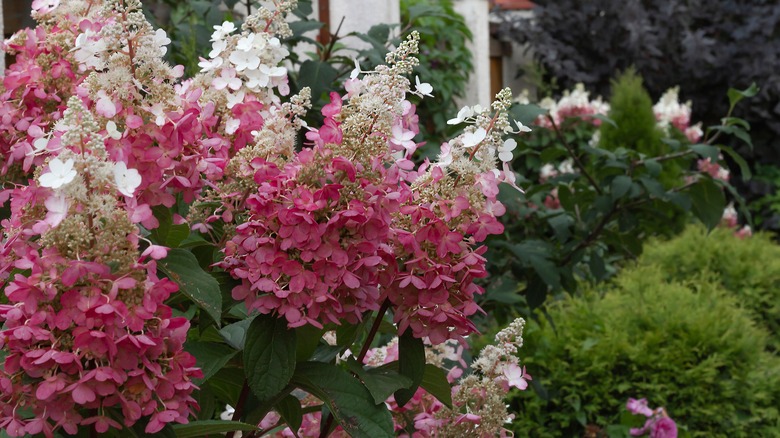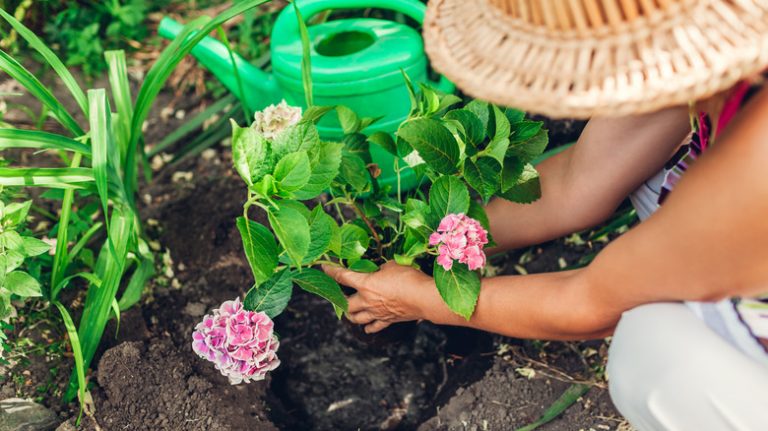The Vanilla Strawberry plant, scientifically known as Hydrangea paniculata, is a stunning color-changing shrub that captivates with its exquisite beauty. This ornamental plant undergoes a mesmerizing transformation throughout the growing season, making it a coveted addition to any yard. Initially, in late spring and early summer, the Vanilla Strawberry plant produces large conical clusters of creamy-white blossoms. These flowers emit a delicate, vanilla-like fragrance, creating a sensory delight in the garden. However, what truly sets this plant apart is its ability to change color as the season progresses. As the summer heat intensifies, the white blooms gradually transition to shades of blush pink, deepening into a rich strawberry hue by late summer and early fall. This evolving spectrum of colors makes the Vanilla Strawberry plant a dynamic focal point that adds visual interest and dimension to any landscape.
Additionally, these hardy and low-maintenance shrubs thrive in various soil conditions and climates, making them accessible and adaptable for a wide range of homeowners. Furthermore, their robust growth and beautiful blooms attract pollinators like bees and butterflies, contributing to a healthier ecosystem. Thus, the Vanilla Strawberry plant’s ability to transform its color and enhance the garden’s aesthetics, low-maintenance requirements, and ecological benefits make it an appealing choice for homeowners looking to elevate the beauty of their yards.
How to care for Vanilla Strawberry Hydrangeas

Caring for the Vanilla Strawberry Hydrangea is relatively straightforward and can lead to a healthy and vibrant plant. Choose a suitable location for your Vanilla Strawberry Hydrangea. They prefer well-draining soil with good organic content and thrive in partial to full sunlight. Plant them in an area where they receive morning sun and afternoon shade to prevent scorching of the leaves. Ensure proper spacing, as they can grow six to seven feet tall and wide. Hydrangeas need consistent moisture to flourish. Water your Vanilla Strawberry regularly, especially during dry spells. Water deeply to saturate the root zone, but avoid waterlogged soil. Applying a layer of mulch around the base of the plant can help retain moisture and regulate soil temperature.
Pruning your hydrangea is essential to maintain the shape and size of your Vanilla Strawberry. It’s best to prune in late winter or early spring before new growth begins. Remove dead or weak branches and cut back old growth to encourage new shoots. You can also deadhead the faded blossoms to promote further flowering throughout the season. Hydrangeas benefit from occasional fertilization. Apply a balanced, slow-release fertilizer to provide essential nutrients. Avoid excessive use of high-nitrogen fertilizers, as this can lead to excessive leaf growth at the expense of flower production. In regions with harsh winters, consider providing winter protection by covering the base of the plant with a layer of mulch and wrapping the shrub with burlap.
What to know about Vanilla Strawberry’s blooming habits
Encouraging a Vanilla Strawberry Hydrangea to bloom prolifically requires a combination of proper pruning techniques, optimal growing conditions, and attentive care. Avoiding common hydrangea pruning mistakes is crucial for maximizing its flowering potential. Many people mistakenly prune these hydrangeas in early spring, which can remove potential flower buds. Instead, prune in late fall or winter before new growth begins, trimming away dead or weak branches while sparing the emerging buds. Cutting back old growth can stimulate new growth and more flower buds, but avoid cutting too much, as this may reduce the number of blooms in the current season.
Contrary to some hydrangea varieties, soil pH does not significantly impact the color of Vanilla Strawberry Hydrangea blooms. Instead, these hydrangeas are known for their remarkable color-changing abilities based on temperature fluctuations. Warmer daytime temperatures and cooler nights induce the transition of their creamy white flowers to shades of pink and deep red. Nighttime temperatures below 50°F (10°C) trigger the most vivid color change. This unique feature sets them apart from other hydrangeas, making them particularly attractive for gardeners who appreciate a dynamic display of colors, regardless of the soil’s pH level. While regular monitoring and maintenance of the soil pH will encourage the plant to produce healthier blooms, it will not impact the color with any noticeable difference. Finally, to promote more blooms, consider fertilizing your hydrangea with a balanced, slow-release fertilizer in early spring.
